If you’re interested in learning more about the Salem Witch Trials, you may want to read one of the many books published on the topic.
Hundreds of books have been written about the Salem Witch Trials since they first took place in 1692.
This is despite the fact that in October of 1692, Governor Phips ordered a publication ban on books discussing witchcraft and the Salem Witch Trials, fearing it would only fan the flames and incite more fear.
This ban didn’t apply to Boston minister, Cotton Mather, whose father had personally recommended Phips for the job of Governor of the Province of Massachusetts Bay.
As a result, Mather’s book, Wonders of the Invisible World, was the first official book published on the Salem Witch Trials when it came out in October of 1692.
The other ministers and various people involved in the Salem Witch Trials also published their own books and memoirs on the topic prior to the ban and in the years that followed.
These books, along with the actual court records, are the primary sources on the trials and later become the main source material for contemporary books on the topic.
In the 19th century, a renewed interest in history spurred a second wave of books on the trials, starting in 1867 with a book titled Salem Witchcraft by the former Salem mayor Charles W. Upham. The books have kept coming ever since then and they don’t seem to be slowing down anytime soon.
With so many books to choose from, it’s hard to know where to start. Many of the primary sources are invaluable references, but, due to their age, they are a bit outdated and the dense language makes it hard for modern readers to get through.
The books published since then, particularly in the 20th and 21st centuries, are much more accessible and easier for readers to understand and also offer a fresh, modern perspective on the trials.
With that in mind, I’ve compiled a list of what I think are the best books on the Salem Witch Trials. The list includes nonfiction as well as fiction books. These books mentioned here are some of the best-selling books on the topic and have great reviews on sites like Amazon, Goodreads and etc.
I myself have also used these books in my research for this website (expect for the fiction books) and can personally recommend them as some of the best books on the trials:
(Disclaimer: This article contains Amazon affiliate links. As an Amazon Associate I earn from qualifying purchases.)
 1. The Salem Witch Trials: A Day by Day Chronicle of a Community Under Siege by Marilynne K. Roach
1. The Salem Witch Trials: A Day by Day Chronicle of a Community Under Siege by Marilynne K. Roach
Published in 2002, this book explains the details and the events of the Salem Witch Trials as they happened.
Each chapter covers each month during the trials, starting in January of 1692 when the Salem Village girls first showed signs of being afflicted.
Since the events and chronology of the trials can get confusing and complicated at times, this book is great at sorting out exactly what happened and when.
Roach has written a number of books on the Salem Witch Trials and I actually highly recommend her other books as well, which includes: Six Women of Salem: The Untold Story of the Accused and Their Accusers in the Salem Witch Trials and a children’s book titled In the Days of the Salem Witchcraft Trials.
Roach is a member of the Gallows Hill Project which, in January of 2016, officially confirmed Proctor’s Ledge in Salem as the location of the witch trial hangings.
After I published this blog post in February of 2016, I got an email from author Emerson W. Baker in which he explained how important Roach’s book was to his research for his own book, A Storm of Witchcraft, stating: “I am in awe of her work, and as I have told her – I never could have written my book without her day by day chronicle.”
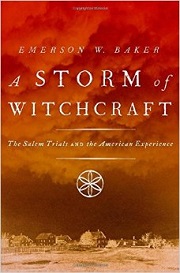 2. A Storm of Witchcraft: The Salem Witch Trials and the American Experience by Emerson W. Baker
2. A Storm of Witchcraft: The Salem Witch Trials and the American Experience by Emerson W. Baker
Published in 2014 by Oxford Press, this book not only describes the details of the trials, but it also explores the larger context by looking at the events that led up to and influenced the trials, such as King Philip’s war and the new Massachusetts Bay Colony charter issued in 1691.
In doing so, it provides an overview of the colony in the 17th century and explains how the setting for the witch hysteria in 1692 developed slowly over time.
Each chapter is about a different aspect of the witch trials, such as the history of Salem and the influence it had on the mass hysteria in 1692, the town politics of Salem Village, and the different groups of people involved in the trials such as the judges, the accused and the accusers. The last few chapters are devoted to the aftermath of the trials, which is a topic many books about the witch trials often overlook.
Baker is a professor at Salem State University and is also a member of the Gallows Hill Project that confirmed the witch trials execution site in 2016 and was featured in many of the articles and television interviews about the discovery.
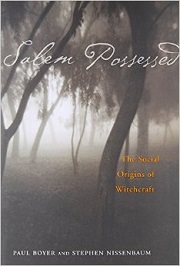 3. Salem Possessed: The Social Origins of Witchcraft by Paul Boyer and Stephen Nissenbaum
3. Salem Possessed: The Social Origins of Witchcraft by Paul Boyer and Stephen Nissenbaum
Published in 1974 by Harvard University Press, this book explores the social setting and history of Salem prior to the witch trials to provide a better understanding of how and why they happened.
The book explores issues that occurred in Salem just prior to the trials such as factionalism, land disputes, family rivalries and church disputes.
In the intro, Boyer and Nissenbaum state that up until the time this book was published almost no other historians had explored these issues before and explained the only one that had come close was Charles W. Upham in his 1867 book Salem Witchcraft. When they realized this, it encouraged them to write this book to give readers a more thorough understanding of the trials.
Boyer, who passed away in 2012, was a professor of history at the University of Wisconsin who earned his Phd from Harvard. He was also a member of the Academy of Arts and Sciences, the Society of American Historians and the American Antiquarian Society.
Nissenbaum is a professor of history at the University of Massachusetts at Amherst. He received a doctorate of history at the University of Wisconsin-Madison.
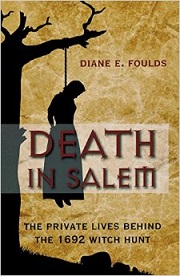 4. Death in Salem: The Private Lives Behind the 1692 Witch Hunt by Diane Foulds
4. Death in Salem: The Private Lives Behind the 1692 Witch Hunt by Diane Foulds
Published in 2010, instead of looking at the big picture or listing the chronology of the events, this book explores the personal lives of the people involved in the trials to form a sort of psychological profile of the colony at the time.
The book details each person’s name, age, place of residence and explores the personal circumstances that spurred each person to act as they did.
The chapters are divided by the roles each group of people played in the trials, such as the accusers, the victims, the clergy, the judges and the elite (the wealthy outsiders and government officials.)
The book really helps the reader understand what life was like for these individuals at the time and puts their actions into perspective. It brings a much needed humanizing aspect to this complex topic.
Diane Foulds is a Vermont native who has written for numerous publications such as the Boston Globe and Yankee Magazine Travel.
Despite the fact that Foulds is not a historian and mostly writes on travel-related topics, she does a great job of delving deep into the lives of the people involved in the trials and exploring their personal stories.
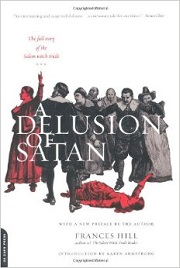 5. A Delusion of Satan: The Full Story of the Salem Witch Trials by Francis Hill
5. A Delusion of Satan: The Full Story of the Salem Witch Trials by Francis Hill
Published in 1995, this book explores the psychology and social issues behind the Salem Witch Trials. The book theorizes that the trials were caused mostly by issues such as fear, religion and politics.
The book explains that the trials were the result of a repressed society acting out its greatest fears and lashing out against those they deemed responsible for their suffering.
A Delusion of Satan also details the similarities between the Salem Witch Trials and modern day witch hunts such as the communist scare in the 1950s and the Islamophobia brought about after September 11, 2001.
Francis Hill is a British novelist and journalist who has written multiple other books on similar topics such as The Salem Witch Trials Reader, Hunting for Witches and Such Men are Dangerous.
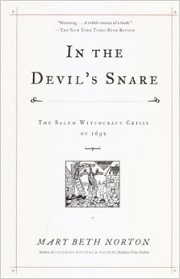 6. In the Devil’s Snare: The Salem Witchcraft Crisis of 1692 by Mary Beth Norton
6. In the Devil’s Snare: The Salem Witchcraft Crisis of 1692 by Mary Beth Norton
Published in 2002, this book suggests that the community of Salem was living in a constant state of fear at the time and this fear is what set the stage for the mass hysteria and the witch trials.
Norton argues that the people of Salem felt they were under attack and believed the Devil was responsible for their suffering.
Salem residents at the time were suffering from numerous problems, from disease outbreaks to war to crop failures, and they believed at the time that witches and the devil were often behind such unfortunate events. The book is laid out chronologically to help readers understand these events as they happened.
Norton is a historian and a professor of American History at Cornell University. She has written numerous books about American history, including Founding Mothers and Fathers, and has appeared in many documentaries and history programs about the Salem Witch Trials, such as The History Channel’s program Witch Hunt and the National Park Service’s educational film Salem Witch Hunt: Examine the Evidence.
 7. The Devil in Massachusetts: A Modern Enquiry into the Salem Witch Trials by Marion L. Starkey
7. The Devil in Massachusetts: A Modern Enquiry into the Salem Witch Trials by Marion L. Starkey
Published in 1949, The Devil in Massachusetts takes the dialogue of the Salem Witch Trials court records and uses it to tell the story of the trials in a dramatic narrative.
Starkey also applies modern psychology to the events to help explain what they really mean.
Many authors of newer books on the trials have cited The Devil in Massachusetts as one of the first well-researched and investigative books on the Salem Witch Trials.
In the preface of Salem Possessed: The Social Origins of Witchcraft, authors Paul Boyer and Stephen Nissenbaum, said of the book: “despite its occasional imaginative embellishments [The Devil in Massachusetts] remains the best researched and certainly the most dramatic account of the events of 1692.”
Author of the Delusion of Satan, Francis Hill, also cited it as an important book on the topic but pointed out that since it was published so long ago it’s a little outdated.
Starkey, who died in 1991, was a former newspaper editor who later became an author. She wrote numerous other history books including The Visionary Girls: Witchcraft in Salem Village, Cherokee Nation and The First Plantation: A History of Hampton and Elizabeth City County, Virginia 1607-1887.
 8. The Crucible by Arthur Miller. The Crucible is a play that first premiered on Broadway in 1953.
8. The Crucible by Arthur Miller. The Crucible is a play that first premiered on Broadway in 1953.
Although the play is set in Salem in 1692 and depicts the events of the Salem Witch Trials, it is actually an allegory for the Red Scare that took place in the United States in the 1950s.
In the Crucible, Miller was comparing the witch hunt in Salem to the witch hunt for Communists in the 1950s.
The Crucible is both a blessing and a curse for anyone interested in learning more about the Salem Witch Trials. On the plus side, it was responsible for kick starting a renewed interest in the witch trials and it fueled the start of the tourism industry in Salem.
Yet one major drawback is, because it is based on the trials many readers mistaken believe that the play is historically accurate and think many of the things that happened in the play actually happened in real life.
As a result, a lot of myths and misunderstandings have stemmed from this play as well as the movie adaptation released in 1996. Although the play is pretty close to being historically accurate, it isn’t completely and readers should remember to take it for what it is, a fictionalized account of the trials.
Miller took a lot of liberties with the story, which he had the right to do as a playwright, and injected his own theories, ideas and events.
For example, Miller was convinced, after reading the court documents about Elizabeth Proctor’s trial, that Abigail Williams and John Proctor had an affair and made that idea the main plot of the play. This has never been proven and seems highly unlikely given the age difference between Proctor and Williams but it was Miller’s theory so he used it as a plot device.
Miller was inspired to write The Crucible after reading Charles W. Upham’s book titled Salem Witchcraft. The book was one of the first contemporary books published on the topic and is cited as an important historical book on the topic.
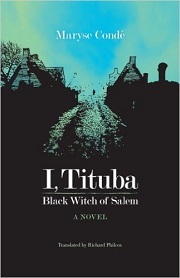 9. I, Tituba, Black Witch of Salem by Maryse Conde
9. I, Tituba, Black Witch of Salem by Maryse Conde
Originally published in French in 1986 and later translated to English, this novel is a fictionalized account of the life of Tituba, a slave of Reverend Samuel Parris, who was one of the first women accused of witchcraft during the Salem Witch Trials.
Since not much is actually known about Tituba’s life before or after the trials, the author creates a fictional tale about Tituba’s childhood, teenage years, life in Salem and her life after the trials.
This novel is interesting because Tituba is an often overlooked individual in the trials and this novel tries to remedy that by shining a light on her life. In doing so, the novel explores the role of gender and race in the witch trials and challenges traditionally white, male dominated historical narratives.
Conde, a French author and former professor at Columbia University, has written numerous historical fiction novels, including the book Segu. Her novels typically explores social issues such as race and gender.
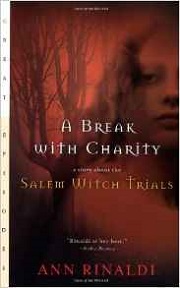 10. A Break With Charity: A Story About the Salem Witch Trials by Ann Rinaldi
10. A Break With Charity: A Story About the Salem Witch Trials by Ann Rinaldi
Published in 1992, this novel is a fictionalized account of the afflicted girls of Salem Village.
The story is about Susannah English, daughter of accused witches Phillip and Mary English and friend of Ann Putnam, Jr.
The story explores the theory that the afflicted girls were lying about their afflictions in an attempt to punish people that their families disliked.
The protagonist must decide between keeping quiet in order to protect herself and her family from false accusations or bring the witch trials to an end by telling the truth about the girl’s claims.
Although Susannah English was a real person in Salem and her parents were actually accused of witchcraft in 1692, it’s important to note that she was not one of the actual afflicted girls in real life and the plot of the novel is purely fictional.
Rinaldi is a former newspaper columnist who later became an author. She has written numerous historical fiction novels including Hang a Thousand Trees with Ribbon and An Acquaintance with Darkness.
Additional Reading:
If you want to find out even more about the witch trials and you’re not put off by historical texts, I also highly recommend Charles W. Upham’s book Salem Witchcraft: With An Account of Salem Village and a History of Opinions on Witchcraft which was published in 1867.
This book doesn’t get great reviews from modern readers because it is a bit dry and the language is old-fashioned. Yet, for scholars, students and researchers who are used to historical texts and want to study the trials more in-depth it is an absolutely essential book that can’t be overlooked.
As I mentioned before, Salem Witchcraft was the book that inspired Arthur Miller to write The Crucible. It was one of the first comprehensive books about the Salem Witch Trials.
Since it is an outdated historical text, it has its flaws and sometimes gets a few facts wrong (for example, Upham confuses Sarah Bishop with Bridget Bishop and merges them into one person) but is otherwise a great read.
If you like historical texts like this I also recommend reading any of the primary sources on the Salem Witch Trials, which were all written by the local ministers involved in the trials.
Although the language in these books is also antiquated, they offer a very unique firsthand perspective on the topic that you can’t find in any other book:
♦ A Brief and True Narrative of Some Remarkable Passages Relating to Sundry Persons Afflicted by Witchcraft, at Salem Village: Which happened from the Nineteenth of March, to the Fifth of April, 1692; Deodat Lawson; 1692
♦ A Modest Enquiry Into the Nature of Witchcraft; John Hale; 1702
♦ More Wonders of the Invisible World, Robert Calef; 1700
♦ The Wonders of the Invisible World: Being an Account of the Tryals of Several Witches Lately Executed in New-England; Cotton Mather; 1692
Sources:
Morrow, James. “James Morrow’s Top 10 Best Books About Witch Persecutions.” The Guardian, Guardian News and Media limited, 18 April. 2006, theguardian.com/books/2006/apr/19/top10s.witch.persecution
“What is the best book on the Salem Witch Trials?” Quora, quora.com/What-is-the-best-book-on-the-Salem-witch-trials


Carol F. Karlsen, The Devil in the Shape of A Woman: Witchcraft in Colonial New England
That’s a good book too. I almost included it in the list but the only reason I didn’t is because it isn’t exclusively about the Salem Witch Trials. It does talk about the Salem trials though so I guess it technically qualifies as a Salem Witch Trials book.
Do you have any thoughts on the recent book “The Witches: Salem, 1692?” I haven’t read it, but I’m interested in what someone who knows a lot more than I do about the subject thinks.
I haven’t read it yet either. The only thing I can really say about it is I noticed a lot of negative reviews from readers suddenly flooding in on Amazon.com after it was released. Critics seem to like it but readers say the complex dialogue and prose make it difficult to read.
The Witches: Salem, 1692 is a great book.It’s a little redundant and scattered but it is a compelling book.
I saw a CSPAN reading for the book this summmer (there are many readings on YouTube) and I was disappointed to learn almost nothing new but the phase of the moon for a particular event, though I was impressed with the level of detail of research to have consulted astronomical charts to elucidate a detail. She seemed to have done a lot of close reading at the PEM. To be fair living hear I hear a lot of information, and haven’t read it, so I can’t say how much new info I would get upon closer inspection.
I’m doing a lot more reading on Revolutionary History, tbh, before spending much more time on the Trials at this point. The new Book “Prelude to Revolution” by Hoffer is a great discussion of Leslie’s Retreat (which is gravely overlooked IMHO) and an older book by Tagney “The World Turned Upside Down: Washjington in Essex County” is also great. YMMV
“A Storm of Witchcraft” by Emerson Baker is my favorite of those above listed. It was the most insightful to me.
I just got a First Edition of Robotti’s Chronicles of Old Salem (1948) and it is AMAZING. I cannot recommend it highly enough.
Also SSU’s Professor Emerson Baker’s research group (book #2) sells two iOS apps with GPS locations of locations of historical events and landmarks created by PVIMaine.com
1) Salem Witch Trials for the iPhone and iPad ($5 as of this September) and
2) Lexington and Concord for the iPhone and iPad ($5 as of this September)
(I have no affiliation and do not benefit from any sales)
Cheers!
I certainly want to thank you for these recommendations. I’ve read four or five books on the subject of the Salem witchcraft trials, including the book first mentioned here by Marilynne K. Roach. I thought this one was the best at explaining the confusion over the identities of Sarah Bishop and Bridget Bishop. I had sorted this mixup out myself and was happy to see it seconded by a scholarly researcher like Roach.
My interest in verifying the identities of these two women, as well as those of their husbands (two distinct Edward Bishop’s), was that I’m a descendant of Sarah Wildes and her husband Edward Bishop (1648-1712), who lived in Salem Village. As you know, both Sarah and Edward were accused and jailed on suspicion of being witches. I relied on every source I could find, including some very helpful deeds and town tax records. The deeds helped the most in sorting out the four men named Edward Bishop in 1692 because they each had unique marks or ways of signing these documents. The Edward married to Bridget signed with a simple “X”; Edward who was married to Sarah signed his whole name, whereas his father Edward, Sr. signed with his initials, E.B. And Edward the third also signed his full name but could be identified by the unique figure used as a mark by his wife, Susan. Also, I was able to establish that while Bridget and Edward Bishop, “the sawyer”, lived in the town of Salem, my Bishop ancestors lived in Salem Village and Beverly.
Thank you again for this article. I can’t wait to get my hands (and eyes) on some of these other books about this fascinating time in our history.
I recently read “The Witches” (or rather had it read to me via Audible) and I found it poetic and compelling. I had just come from “A Storm of Witchcraft” (also on Audible). Both fabulous books–from different angles.
PS. Wrote a week or so ago seeking permission to publish the Susannah Martin memorial photo in our local quarterly genealogical journal. An interview with a descendant of hers. Hope I can use it–with citation and credit, of course.
Hello, was wondering where you got the quote from the authors of Salem Possessed on Starkey’s book? It’s a great quote and I’d love to be able to cite it
I found it in the preface of Salem Possessed.
I just visited Salem as a tourist last week and am really looking forward to reading more about the witch trials. Thank you for such a great post – it’s going to be very helpful as I plan my reading!
The only book I’ve read about the trials (apart from Miller’s Crucible) is “The Witches,” mentioned above. I enjoyed it, although it does quote primary source language extensively and that sometimes got a little confusing. But I thought Schiff did a great job of getting readers inside the Salem villagers’ heads – not excusing the hysteria, but helping modern readers understand how it could have happened. (For instance, she makes much of just how *dark* and *quiet* nighttime in colonial America could be — something so simple, but that modern city-dwellers could tend to forget). If you’ve read this book since you responded to the posts above, I’d love to hear your take on it.
Are there any good films or documentaries (again, apart from version of The Crucible) you would recommend?
I haven’t read “The Witches” yet so I still don’t have an opinion on it. For some ideas on tv shows and movies, here’s my article about Salem Witch Trials movies and tv shows https://historyofmassachusetts.org/salem-witch-trials-movies-t-v-shows/. I particularly like Three Sovereigns for Sarah, which is a PBS mini-series from the 80s. There’s a couple of documentaries on the list but I haven’t seen them yet.